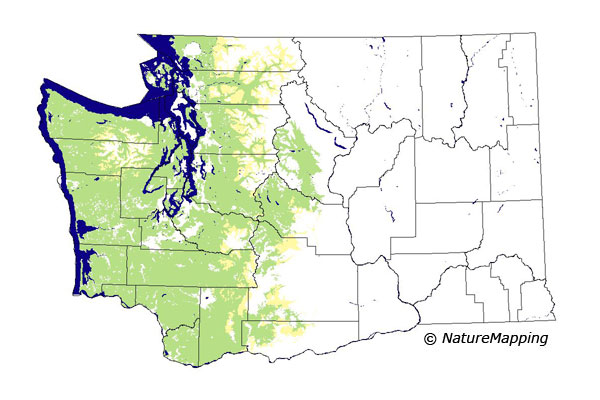GAP Analysis Predicted Distribution Map
Roughskin Newt (Taricha granulosa)
Species Code: TAGR
|
Legend:
 = Core Habitat = Core Habitat
 = Marginal Habitat = Marginal Habitat
Metadata
(Data about data or how the map was made)
Predicted Distribution
Amphibians do not migrate as some birds and mammals, so the colored areas depict the predicted range for the Roughskin Newt year-round. The habitats were identified using 1991 satellite imagery, other datasets and experts throughout the state, as part of the Washington Gap Analysis Project.
Click to enlarge distribution map
|
Distribution and Habitat Requirements
The Roughskin Newt is most commonly found in moderately moist forests of conifers, and/or hardwoods. It has been found on Camano, Cypress, Lopez, San Juan,
and Orcas Island. It may be found far from ponds after the breeding season.
River and stream floodplain pools may offer good habitat If residual downed logs from a former conifer stand and wetlands are present,
this species may inhabit alder tree stand areas.
Models
All the ecoregions west of the Cascades, the East Central Cascades and Southeast Cascades, plus areas into the edge of the Columbia Basin were selected.
The treatment of zones varied with the ecoregion. In the Inner and Outer Olympic Peninsula, Puget Trough, Willlamette Valley and Southwest Cascades
ecoregions, the lower elevation zones up to and including Silver Fir were core areas. Subalpine Fir and Mountain Hemlock were marginal.
In the Northwest Cascades, the Western Hemlock zone was core and the Interior Douglas-fir and Silver Fir zones were marginal.
In the Southeast and East Central Cascades, Interior Douglas-fir, Grand Fir, Western Hemlock and Interior Western Hemlock were core zones.
Oak, Ponderosa Pine, Mountain Hemlock and Three-tip Sage zones were marginal. In the Columbia Basin, Three-tip Sage, Central Arid Steppe,
Klickitat Meadow Steppe, Bitterbrush, Oak and Ponderosa Pine zones were marginal, because populations in these vegetation zones are very rare.
Lakes and riparian areas (areas along rivers and streams) were good habitats in all zones.
Generally all classes of open and closed-canopy hardwood, hardwood/conifer and conifer forests, low density developed residential areas
including parks and golf courses were suitable if appropriate microhabitats existed. Only lakes and riparian areas, closed-canopy hardwood/conifer and
conifer forests were selected in the Columbia Basin.
Translated from the Washington Gap Analysis Amphibians and Reptiles Volume by Karen Dvornich
Webpage designed by Dave Lester

 = Core Habitat
= Core Habitat = Marginal Habitat
= Marginal Habitat